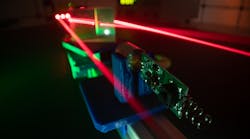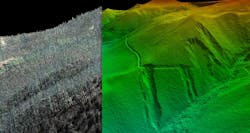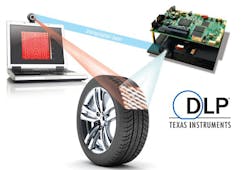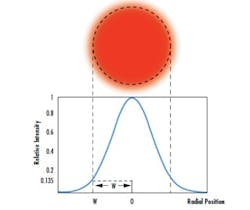This article is part of the Power Management Series: Delving Into Power Density.
Members can download this article in PDF format.
What you'll learn:
- Calculating laser power density
- What is a LiDAR point cloud?
- Wide array of applications for lasers.
To compute laser power density (power/unit area or irradiance), we will need a value for the diameter of the beam coupled with the value of the fraction of total power transmitted within that diameter. Average power and power density can be easily calculated here or here.
LiDAR (light detection and ranging) can measure the distance of an object (measuring the time for the reflected light beam to return to the receiver) using pulsed lasers. It also can create a 3D image of an object.
LiDAR Point Cloud
LiDAR point clouds2 are typically described by their unique technology of dynamic information storage. See the U.S. Geological Survey (USGS) point cloud references here.
By processing a LiDAR point cloud to bare-earth digital elevation models (DEMs), vegetation can be stripped away to reveal past landslides and steep slopes, at risk of failure, masked by forested canopies (Fig. 1). In dense forests, landslides—especially old landslides—might be invisible on aerial images; they are hard to detect from the ground.
1.Shown is a LiDAR point cloud (left) and bare-earth DEMs (right). The vegetation is stripped away to reveal past landslides and steep slopes. (Image from Reference 2)
Texas Instruments (TI) probably has the widest array of laser-scanning solutions. One unique solution that stands out in its laser product line is digital light processing (DLP) technology in the form of digital micromirror devices (DMDs). Designers can construct their point cloud, which will be able to accelerate their machine-vision (MV) solutions with help of TI’s DLP software development kits (SDKs) (Fig. 2).
2. This image demonstrates the function and capability of Texas Instruments’ DLP development kits. (Image from Reference 3)
Gaussian Beam Propagation
Laser beams are termed Gaussian when they have an irradiance profile that’s following an ideal Gaussian distribution (Fig. 3).
3. In this Gaussian beam distribution, the “waist” of the beam is the location in which the irradiance is 1/e2—13.5% of its maximum value. (Image from Reference 7)
Laser Applications
1. Photobiomodulation (PBM) can produce photochemical effects via modulating living cells. This method is used for incoherent (light-emitting diode) or coherent (laser) light with wavelengths that range from 405 to 1,100 nm.
PBM, an external stimulus in this application, accelerates the production of biological factors, reduces inflammation, and enhances tissue healing and repair. It also has been found to promote efficient functioning in such areas such as diabetes, brain injury, spinal-cord injury, skin disease, dentistry, and more.
In bone injuries, PBM reduces inflammation, will improve the biological effect of osteoblasts, promote bone regeneration, and accelerate the healing of bones. This method has a non-traumatic advantage.
2. Automotive laser-beam fusion welding joins components at high welding speeds with low thermal distortion. The laser beam is a concentrated heat source, focused on the cavity between any two metal pieces to be joined. This process is often employed in the automotive industry in high-volume applications.
3. Holography is made possible via a laser source in which a coherence length, greater than 1 m, is sufficient to write holograms. A beam of coherent light (from the laser) is split—half of the beam will fall on a recording medium (like a photographic plate) unaltered, and the other half first gets reflected off the object to be imaged. Together, these two beams will produce an interference pattern of stripes and spirals/concentric circles or “whorls” on the photographic plate. The developed plate is the hologram.
4. Lasers can accelerate some chemical reactions: Chemists typically can’t mix their reactants together until the very instant they’re ready for the reaction to proceed. A low-cost laser can be used to trigger and accelerate a chemical reaction for printing, or even to regulate drug delivery within the human body.
5. Distance calculation: Just like sonar, a laser beam can be employed in surveying and ranging/distance calculation with no need for physical contact. Laser measuring tools function by transmitting a light beam to the target, which will then reflect off the surface and reflect back to the sending device. Lasers can measure distance with a great deal of accuracy.
6. Garment manufacturing industry: The garment industry uses lasers for cutting garment patterns, 3D body scanning, fading for denim, and leather engraving.
7. Security and defense: Laser technology is being applied in perimeter security, target designation, and monitoring of toxic gases. The military also uses lasers in directed energy weapons.
8. Medical: Companies such as Modulight have provided lasers in medical applications, such as cancer treatment, with genetics/drug discovery/diagnostics as well as for ophthalmology.
9. Cinema: Lasers are used by many of the leading cinema projector companies.
10. Communication: 5G, data centers, and optical time-domain reflectometry (OTDR) all leverage lasers in their designs
Summary
Laser power density can be determined by the laser power divided by its cross-section area or beam size. Power density is the power per unit area, aka irradiance, and is typically expressed in terms of W/cm2. Today, there are myriad applications that take advantage of the benefits of laser technology.
Read more articles in the Power Management Series: Delving Into Power Density.
References
1. Study on the Osteogenic Differentiation of human umbilical cord mesenchymal stem cells (hUCMSCs) in Silk Fibroin/Polycaprolactone Membrane Under the Intervention of Photobiomodulation, IEEE Journal of Selected Topics in Quantum Electronics, Vol. 29, No. 4, July/August 2022.
2. LiDAR point cloud vs. bare earth DEM, U.S. Geological Society (USGS), 2018.
3. Point Cloud Generation and 3D Machine Vision Reference Design, SLYB223, Texas Instruments.
4. LiDAR vs point clouds, Vercator.
5. How to Measure Laser Power Density.
6. Laser Power Density vs. Energy Density.
7. Gaussian Beam Propagation, Edmund Optics.




